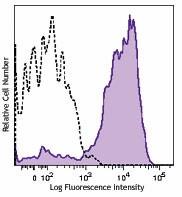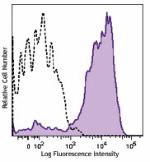- Clone
- 16E5 (See other available formats)
- Regulatory Status
- RUO
- Other Names
- Trem-l4, TREM like transcript 4, triggering receptor expressed on myeloid cells-like 4
- Isotype
- Rat IgG1, κ

-

C57BL/6 mouse splenocytes were stained with Treml4 (clone 16E5) PE (filled histogram) or rat IgG1, κ PE isotype control (open histogram). Data shown was from gated on CD8+CD11c+ cells.
| Cat # | Size | Price | Quantity Check Availability | ||
|---|---|---|---|---|---|
| 143303 | 25 µg | $153.00 | |||
| 143304 | 100 µg | $360.00 | |||
Trem-like 4, a type I transmembrane protein and a member of the TREM family, consists of a single extracellular Ig-like domain of the V-type, a transmembrane domain, and a short cytoplasmic domain. Trem-like 4 is expressed on macrophages in the spleen, and dendritic cells, especially CD8+ dendritic cells. It is proposed to regulate the immune response based on its expression profile. It has been reported that B7-H3 is a receptor and that the soluble form of Treml4 has a binding affinity to late apoptotic or necrotic cells.
Product Details
- Verified Reactivity
- Mouse
- Antibody Type
- Monoclonal
- Host Species
- Rat
- Immunogen
- Extracellular domain of recombinant mouse Trem-like 4
- Formulation
- Phosphate-buffered solution, pH 7.2, containing 0.09% sodium azide.
- Preparation
- The antibody was purified by affinity chromatography and conjugated with PE under optimal conditions.
- Concentration
- 0.2 mg/ml
- Storage & Handling
- The antibody solution should be stored undiluted between 2°C and 8°C, and protected from prolonged exposure to light. Do not freeze.
- Application
-
FC - Quality tested
- Recommended Usage
-
Each lot of this antibody is quality control tested by immunofluorescent staining with flow cytometric analysis. For flow cytometric staining, the suggested use of this reagent is ≤0.5 µg per million cells in 100 µl volume. It is recommended that the reagent be titrated for optimal performance for each application.
- Excitation Laser
-
Blue Laser (488 nm)
Green Laser (532 nm)/Yellow-Green Laser (561 nm)
- Application Notes
-
Additional reported applications (for the relevant formats) include: immunofluorescent staining, immunoprecipitation, and Western blotting1.
-
Application References
(PubMed link indicates BioLegend citation) -
- Hemmi H, et al. 2009. J. Immunol. 182:1278. (WB)
- Product Citations
-
- RRID
-
AB_11125372 (BioLegend Cat. No. 143303)
AB_11125372 (BioLegend Cat. No. 143304)
Antigen Details
- Structure
- Type I transmembrane protein; member of the TREM family
- Distribution
-
CD8+ dendritic cells, dendritic cell subsets, macrophages in the spleen, myeloid cells
- Function
- Regulates innate immune response and homeostatis
- Interaction
- Associates with DAP12; binds late apoptotic cells/necrotic cells
- Cell Type
- B cells, Dendritic cells, Macrophages
- Biology Area
- Immunology, Innate Immunity
- Molecular Family
- MHC Antigens
- Antigen References
-
1. Ford JW and McVicar DW. 2009. Curr. Opin. Immunol. 21:38.
2. Hemmi H, et al. 2009. J. Immunol. 182:1278. - Gene ID
- 224840 View all products for this Gene ID
- UniProt
- View information about Trem-like 4 on UniProt.org
Other Formats
View All Trem-like 4 Reagents Request Custom Conjugation| Description | Clone | Applications |
|---|---|---|
| Purified anti-mouse Trem-like 4 (Treml4) | 16E5 | FC,IHC-F,IP,WB |
| PE anti-mouse Trem-like 4 (Treml4) | 16E5 | FC |
Compare Data Across All Formats
This data display is provided for general comparisons between formats.
Your actual data may vary due to variations in samples, target cells, instruments and their settings, staining conditions, and other factors.
If you need assistance with selecting the best format contact our expert technical support team.
-
Purified anti-mouse Trem-like 4 (Treml4)

C57BL/6 mouse splenocytes were stained with Treml4 (clone 16... -
PE anti-mouse Trem-like 4 (Treml4)

C57BL/6 mouse splenocytes were stained with Treml4 (clone 16...
